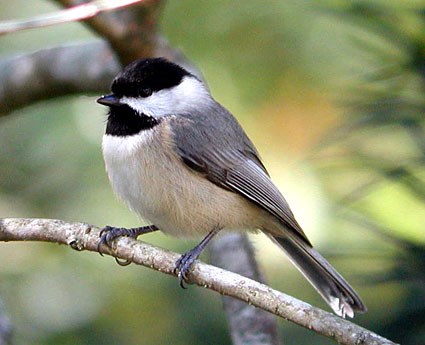On the Wing #60: "My Name is Chickadee....Carolina Chickadee"
So during my first week in New Jersey I've learned two things: 1. Living on a wildlife preserve is the most amazing thing I think I've ever done in my life (which will lead to an important announcement at the end of this blog post) and 2. The main species of chickadee here are Carolina Chickadees (Poecile carolinensis).
Now I've seen Carolinas before. Last year when I visited Assateague National Seashore (my girlfriend worked there as a plover steward), I heard their higher pitched and almost raspy calls in the trees above. Now that I'm in New Jersey however, I have hit upon an interesting problem. In New Jersey, both Carolina and Black-capped Chickadees (P. atricapillus) exist practically side by side, with Black-caps occupying the more northerly areas, while Carolinas are more central to southerly. Now, one would think that such a difference in range would put them on either side of a well defined line, but as any good birder will note, where their ranges seem to end, many discover that they aren't really that well defined. This is especially true of similar looking species. When ranges meet, they don't just meet, they blend. This week I've already heard people talking about hybrids between the two! Having to determine which is which seems daunting enough, but having to tell if they are mixed is a whole other ball of twine.
Some of you might be wondering if it really is that bad. Maybe I'm hyping just a little how similar these guys are to each other and that one little field mark means the difference between glory and defeat. Well, if you think you can tell the difference, look at these next four pictures to see if you can tell. Two are Black-caps and two are Carolinas.
Think you got it figured out? It's a little tough, but the field guides do a good job at figuring out the two. Peterson recommends using range and voice rather than overall appearance. The voice of the Black-cap is the classic chickadee call; a loud, ringing "chicka-dee-dee-dee-dee", while the Carolina sounds raspy and higher pitched. I liken a Carolina to sounding "Tsika-dee-dee". More noticeably, their songs sound different as well. Black-caps say "fee-bee...........fee-bee..........fee-bee", while Carolinas say "fee-bee-fee-bay". Little differences like that, make it easier to tell the difference between a common look alike and a potential ID snag.
One more thing. With some more time on my hands after settling in this week, I'll be reviving OUT Blog as well. I think it will help me focus on other natural phenomena as well as provide me with a window with which to share with all you good people about what I'm seeing during my time here. This means I'll only update this blog once a week along with OUT but, I figure it'll be alright. Have a great weekend and as always, happy birding ^_^.
Now I've seen Carolinas before. Last year when I visited Assateague National Seashore (my girlfriend worked there as a plover steward), I heard their higher pitched and almost raspy calls in the trees above. Now that I'm in New Jersey however, I have hit upon an interesting problem. In New Jersey, both Carolina and Black-capped Chickadees (P. atricapillus) exist practically side by side, with Black-caps occupying the more northerly areas, while Carolinas are more central to southerly. Now, one would think that such a difference in range would put them on either side of a well defined line, but as any good birder will note, where their ranges seem to end, many discover that they aren't really that well defined. This is especially true of similar looking species. When ranges meet, they don't just meet, they blend. This week I've already heard people talking about hybrids between the two! Having to determine which is which seems daunting enough, but having to tell if they are mixed is a whole other ball of twine.
Some of you might be wondering if it really is that bad. Maybe I'm hyping just a little how similar these guys are to each other and that one little field mark means the difference between glory and defeat. Well, if you think you can tell the difference, look at these next four pictures to see if you can tell. Two are Black-caps and two are Carolinas.
Think you got it figured out? It's a little tough, but the field guides do a good job at figuring out the two. Peterson recommends using range and voice rather than overall appearance. The voice of the Black-cap is the classic chickadee call; a loud, ringing "chicka-dee-dee-dee-dee", while the Carolina sounds raspy and higher pitched. I liken a Carolina to sounding "Tsika-dee-dee". More noticeably, their songs sound different as well. Black-caps say "fee-bee...........fee-bee..........fee-bee", while Carolinas say "fee-bee-fee-bay". Little differences like that, make it easier to tell the difference between a common look alike and a potential ID snag.
One more thing. With some more time on my hands after settling in this week, I'll be reviving OUT Blog as well. I think it will help me focus on other natural phenomena as well as provide me with a window with which to share with all you good people about what I'm seeing during my time here. This means I'll only update this blog once a week along with OUT but, I figure it'll be alright. Have a great weekend and as always, happy birding ^_^.






Comments
Post a Comment